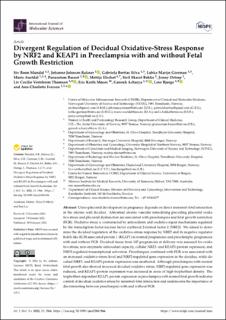| dc.contributor.author | Mundal, Siv Boon | |
| dc.contributor.author | Rakner, Johanne Johnsen | |
| dc.contributor.author | Silva, Gabriela | |
| dc.contributor.author | Gierman, Lobke | |
| dc.contributor.author | Austdal, Marie | |
| dc.contributor.author | Basnet, Purusotam | |
| dc.contributor.author | Elschot, Mattijs | |
| dc.contributor.author | Bakke, Siril Skaret | |
| dc.contributor.author | Ostrop, Jenny | |
| dc.contributor.author | Thomsen, Liv Cecilie Vestrheim | |
| dc.contributor.author | Moses, Eric | |
| dc.contributor.author | Acharya, Ganesh | |
| dc.contributor.author | Bjørge, Line | |
| dc.contributor.author | Iversen, Ann-Charlotte | |
| dc.date.accessioned | 2022-08-12T12:24:10Z | |
| dc.date.available | 2022-08-12T12:24:10Z | |
| dc.date.created | 2022-04-27T11:07:19Z | |
| dc.date.issued | 2022 | |
| dc.identifier.issn | 1661-6596 | |
| dc.identifier.uri | https://hdl.handle.net/11250/3011658 | |
| dc.description.abstract | Utero-placental development in pregnancy depends on direct maternal–fetal interaction in the uterine wall decidua. Abnormal uterine vascular remodeling preceding placental oxidative stress and placental dysfunction are associated with preeclampsia and fetal growth restriction (FGR). Oxidative stress is counteracted by antioxidants and oxidative repair mechanisms regulated by the transcription factor nuclear factor erythroid 2-related factor 2 (NRF2). We aimed to determine the decidual regulation of the oxidative-stress response by NRF2 and its negative regulator Kelch-like ECH-associated protein 1 (KEAP1) in normal pregnancies and preeclamptic pregnancies with and without FGR. Decidual tissue from 145 pregnancies at delivery was assessed for oxidative stress, non-enzymatic antioxidant capacity, cellular NRF2- and KEAP1-protein expression, and NRF2-regulated transcriptional activation. Preeclampsia combined with FGR was associated with an increased oxidative-stress level and NRF2-regulated gene expression in the decidua, while decidual NRF2- and KEAP1-protein expression was unaffected. Although preeclampsia with normal fetal growth also showed increased decidual oxidative stress, NRF2-regulated gene expression was reduced, and KEAP1-protein expression was increased in areas of high trophoblast density. The trophoblast-dependent KEAP1-protein expression in preeclampsia with normal fetal growth indicates control of decidual oxidative stress by maternal–fetal interaction and underscores the importance of discriminating between preeclampsia with and without FGR. | en_US |
| dc.language.iso | eng | en_US |
| dc.publisher | MDPI | en_US |
| dc.rights | Navngivelse 4.0 Internasjonal | * |
| dc.rights.uri | http://creativecommons.org/licenses/by/4.0/deed.no | * |
| dc.title | Divergent Regulation of Decidual Oxidative-Stress Response by NRF2 and KEAP1 in Preeclampsia with and without Fetal Growth Restriction | en_US |
| dc.type | Journal article | en_US |
| dc.type | Peer reviewed | en_US |
| dc.description.version | publishedVersion | en_US |
| dc.rights.holder | Copyright 2022 The Author(s) | en_US |
| dc.source.articlenumber | 1966 | en_US |
| cristin.ispublished | true | |
| cristin.fulltext | original | |
| cristin.qualitycode | 1 | |
| dc.identifier.doi | 10.3390/ijms23041966 | |
| dc.identifier.cristin | 2019409 | |
| dc.source.journal | International Journal of Molecular Sciences | en_US |
| dc.identifier.citation | International Journal of Molecular Sciences. 2022, 23 (4), 1966. | en_US |
| dc.source.volume | 23 | en_US |
| dc.source.issue | 4 | en_US |

